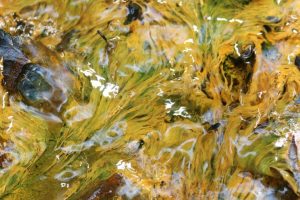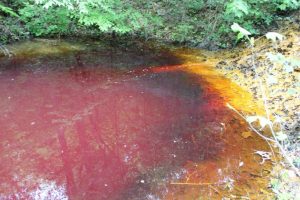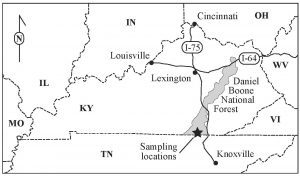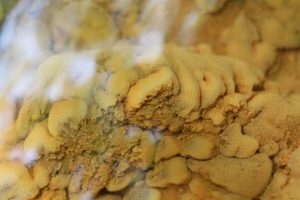31 July 2017
Bacteria found near abandoned mines could shed light on early Earth
Posted by ksimpkins
By Kelsey Simpkins

Green and white filamentous biofilm found at the source of the Cabin Branch sample site, fed by a perennial spring sourced from an area of past coal mining. The white filaments are primarily made up of Ferrovum sp., the bacterium described in the study.
Credit: Jeff Havig / American Geophysical Union
Acidified water draining from abandoned mines, studied primarily as a modern environmental hazard, may offer insight into the oxygenation of Earth’s early atmosphere and development of life on other planets, according to a new study.
Scientists studying abandoned coal mines in Kentucky found evidence for a bacterium capable of oxidizing iron in acidic runoff coming from these sites. These bacteria can survive in a range of conditions – from highly acidic to basic – and thrive on driving oxygen to react with iron and pyrite from rocks in the abandoned mines.
The researchers think these bacteria may be similar to those present during the Neoarchean period 2.8 to 2.5 billion years ago. Despite a lack of free oxygen in the atmosphere during this period, the geologic record shows pyrite in streams and rivers were reacting with oxygen. Scientists think bacteria may have played a role in oxidizing these rocks, using small amounts of locally-produced oxygen. But until now a bacterium that could drive oxidation and survive a wide array of conditions in these environments has remained a mystery.
The new research suggests the abandoned mines – where large amounts of pyrite-bearing rocks are exposed to oxygen in the atmosphere – could mimic continental surfaces during the Neoarchean, where mineral-bearing rocks such as iron pyrite were plentiful. Because the environmental conditions in streams and rivers during the Neoarchean and current acid mine drainage sites are so similar, the research suggests the organisms discovered at the abandoned mines in Kentucky may be the same kind of organisms that were present during the Neoarchean, driving the reactions between oxygen, and iron and pyrite.

This pool is a retention pond put in the outflow of the Cabin Branch site as a form of remediation, to encourage precipitation of iron oxides and other heavy metals before the water reaches the streams and rivers.
Credit: Jeff Havig / American Geophysical Union
The presence of this bacteria could help scientists better understand the environmental conditions leading up to the Great Oxidation Event, a geologically brief period in Earth’s history when the atmosphere shifted rapidly from having no free oxygen to one that contained free oxygen, approximately 2.2 to 2.45 billion years ago. Free oxygen supported the development of organisms that breathe oxygen, eventually leading to multicellular life on Earth.
The study’s results show modern acid mine drainage sites could act as a microcosm of this period. They could also help scientists searching for signs of early life on other planets where the atmosphere may be lacking free oxygen, according to the authors.
“If we go look at planets in other solar systems and want to know what a living planet looks like, maybe we shouldn’t be looking for something that looks like what we’re standing on now, but what it looked like three billion years ago,” said Jeff Havig, a geochemist at the University of Cincinnati and lead author of a new study describing the bacteria in the Journal of Geophysical Research: Biogeosciences, a publication of the American Geophysical Union.
The Perfect Organism

A regional map of the study’s four sampling locations in Daniel Boone National Forest.
Credit: Jeff Havig / American Geophysical Union
Havig and his colleagues, Trinity Hamilton, microbiologist at the University of Cincinnati, and Christy Grettenberger, microbial ecologist at the University of California Davis, sampled four abandoned mine sites in Kentucky’s Daniel Boone National Forest to assess the environmental impact of acid mine drainage.
At these sites, rocks bearing coal and other minerals like iron pyrite or “fool’s gold” were mined out of the ground on large scales. When the pyrite meets oxygen-rich groundwater, the pyrite, primarily made up of iron and sulfide, reacts with oxygen to produce sulfuric acid and dissolved metals like iron. Microbial communities that thrive in these acidic conditions help drive this oxidation process. Acid mine drainage turns rivers orange with iron oxide precipitates, or rust, and the acidity and trace metals released can harm fish, plants and animals.
To understand the environmental impact of the acid mine drainage in Daniel Boone National Forest, the researchers collected water samples and measured pH, temperature and concentrations of elements in the water at four sites. They also took samples to analyze the microbial communities present at the sites.
The researchers discovered one bacteria was prevalent at all the sites they sampled. The bacteria they found can get all the energy it needs by oxidizing pyrite and iron, and can convert nitrogen and carbon dioxide from the atmosphere to produce the nutrients it requires to live. They also found the bacteria at sites with pH ranging from 2.1 to 7.9, as acidic as lemon juice and as basic as seawater.

This biofilm was found in the upper portions of the Co-Op sample site, named for the now closed Co-Op coal mine. It is predominantly made up of the Ferrovum sp. bacterium discussed in the study, and its brain-like texture led the scientists to nickname the abandoned mines ‘zombie mines.’
Credit: Jeff Havig / American Geophysical Union
Because the bacteria are capable of thriving in these diverse conditions, the researchers think one just like it may have lived in rivers which contained pyrite during the Neoarchean. Previous studies have alluded to bacteria like the one found in Daniel Boone National Forest being present during the Neoarchean, 2.8 to 2.5 billion years ago, but the new study provides a direct link that this could have been the case.
The study’s authors argue that the similarities between the modern acid mine drainage sites and the Neoarchean period support the idea that bacteria like what they found near the abandoned Kentucky mines could have been present billions of years ago. At the acid mine drainage sites, pyrite-bearing rocks are exposed to the atmosphere and oxygen-rich water, producing iron and sulfuric acid, and making the surrounding water highly acidic. In the same way, streams and rivers during the Neoarchean were full of minerals like pyrite, which reacted with small amounts of oxygen in streams and rivers produced by photosynthetic organisms. This would have led to the same chemical reactions and acidic water found near acid mine drainage sites today. The new study argues these chemical reactions were driven by the same kind of bacteria as found at the acid mine drainage sites.
“All it needs is a whiff of oxygen and some pyrite, and it can crank,” Havig said. “It can be happy as a clam, it doesn’t need anything else. It’s like this perfect organism to answer who could have lived in this system.”
The presence of this bacteria at these abandoned mines could shed light on lingering questions about the early Earth, according to the study’s authors.
“While most researchers that work on acid mine drainage are focused on understanding the systems with an eye toward remediation and cleanup, we think this is the first study that has directly linked acid mine drainage sites to conditions during the Neoarchean,” Havig said.
— Kelsey Simpkins is a public information intern at the American Geophysical Union and a graduate student in journalism at the University of Colorado Boulder.










 GeoSpace is a blog on Earth and space science, managed by AGU’s Public Information staff. The blog features posts by AGU writers and guest contributors on all sorts of relevant science topics, but with a focus on new research and geo and space sciences-related stories that are currently in the news.
GeoSpace is a blog on Earth and space science, managed by AGU’s Public Information staff. The blog features posts by AGU writers and guest contributors on all sorts of relevant science topics, but with a focus on new research and geo and space sciences-related stories that are currently in the news.